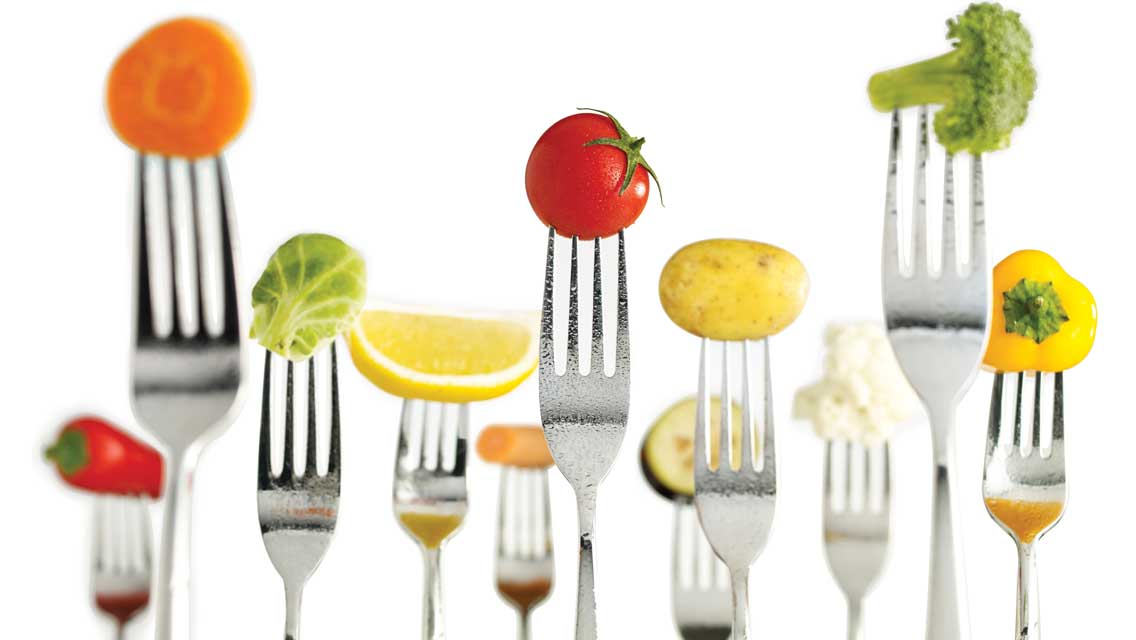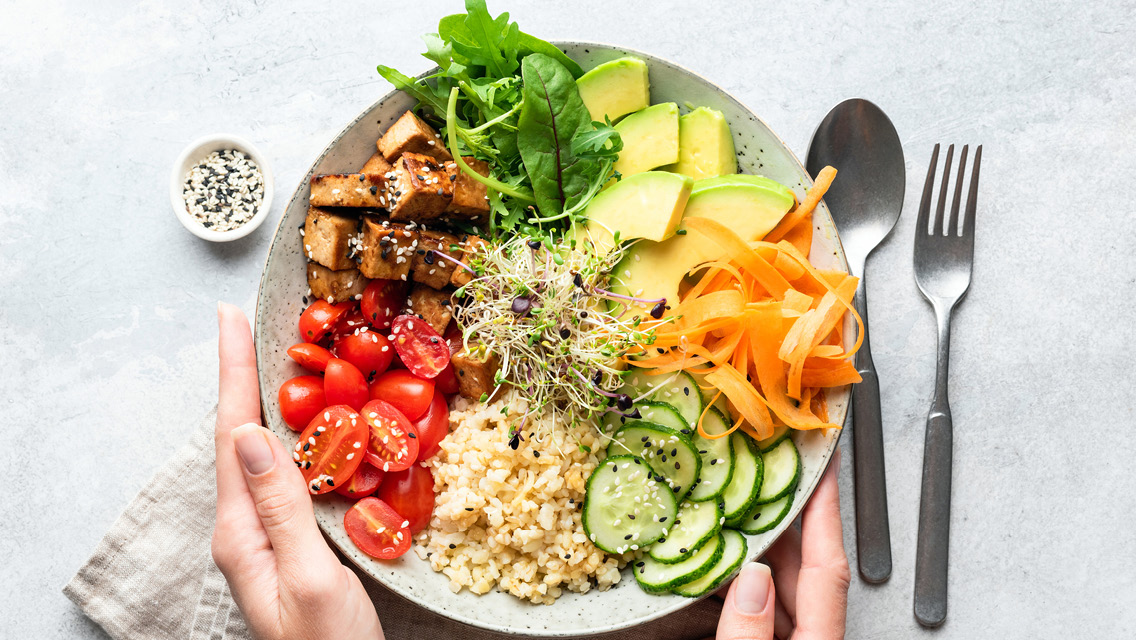Here’s a thought to ponder: What if reaching a healthy weight isn’t about counting calories, depriving yourself of edible pleasures or exercising till you drop? What if it’s simply a matter of finding foods that soothe rather than irritate and inflame your body?
To anyone who has spent years struggling with excess weight, it may sound too good to be true. But according to a growing number of health experts, the premise may be more fact than fiction.
Many alternative-minded health practitioners view reaching and maintaining a healthy weight as a natural byproduct of shifting one’s focus from calories to nutrients, from denying your body to supporting it. This group wants you to toss out everything you thought you knew about dieting, including the word “diet.”
“I like to call it a ‘new eating plan,’” says Elson Haas, MD, medical director of the Preventive Medical Center of Marin in San Rafael, Calif., and author of The False Fat Diet. “People only start losing weight when they stop thinking about calories and start thinking about nutrition.”
This alternative weight-loss theory hinges on the idea that a toxic diet precedes and perpetuates weight gain by triggering imbalances in the body, such as chronic inflammation and metabolic disorders. These experts use the word “toxins” to refer to everything from pesticides to high-fructose corn syrup to any product that can trigger food sensitivities.
“Most people talk about toxins as coming from chemicals in our environment, but the vast majority are created in our guts by the foods we eat,” says Barry Sears, PhD, a former research scientist at Boston University School of Medicine and the Massachusetts Institute of Technology and author of the forthcoming Toxic Fat Syndrome. He notes that the number of toxins in the American diet, including refined carbohydrates and processed vegetable oils, has grown lockstep with the obesity epidemic in the past 25 years. “It’s the perfect nutritional storm,” he says. And one of the best ways to reduce toxins is to curb your consumption of inflammatory foods.
Erin Steinberg is a case in point. The 49-year-old mother and office manager in South Huntington, N.Y., was wafer-thin as a teen but gained weight after the birth of her children. Between family and job demands, she had little time for exercise. Over the years, her weight crept up, and yo-yo dieting only made matters worse. Last year, the 5-foot 11-inch Steinberg tipped the scales at 285 pounds.
At this point, some might choose gastric-bypass surgery. But Steinberg wasn’t interested in going under the knife. She was, however, intrigued when her husband, Harold, suggested she cut wheat from her diet. A physician, Harold was interested in the reported link between chronic inflammation — a frequent response to wheat allergies — and obesity. Erin was game.
Seven wheat-free months later, she is 80 pounds lighter and couldn’t be happier. “For the first time in 30 years, I see definition when I look in the mirror,” she says. “Instead of a rounded outline of my body, I see my waist, my thighs and my knees.”
While weight loss is a nice perk, experts say it is secondary to the good health bestowed on those who clean up their diets. Mark Hyman, MD, author of The UltraSimple Diet, says his patients who have detoxified their diets have conquered everything from migraines to arthritis to asthma.
“The same things that make us sick, make us fat,” he explains. “People need to stop focusing on weight loss and start focusing on getting their bodies back in balance. From there, excess weight will start to drop away automatically.”
Quit Fanning the Flames
For many people, the first step toward balance is to reduce inflammation. A buzzword in some medical specialties, such as heart disease, inflammation is new to the lexicon of obesity, yet its role in weight gain is piquing interest among top scientists.
When nutrition researchers at Harvard Medical School hosted a symposium in March 2007 to discuss the relationship between the two, “the consensus was that inflammation precedes obesity,” says Sears, who attended the meeting.
The process is complex, but here’s the CliffsNotes version:
The immune system’s inflammatory response is a good thing when it happens on a small scale. A localized cut or infection calls for an outpouring of white blood cells to mop up the mess. You see some swelling, some irritation, but within a few days, things are back to normal.
When toxins in the diet irritate the lining of the gut on a constant or near-constant basis, however, the immune system may go into overdrive and can do more harm than good. Swelling and irritation may occur throughout the body. Antibodies build up and start confusing and compromising the body’s organ and endocrine systems. “Many types of biochemical and inflammatory reactions can result from these antibody reactions,” says Haas.
Over time, a food sensitivity like Steinberg’s can trigger an inflammatory response that snowballs into disturbances in hormone levels, brain chemicals and the immune system.
The end result is weight gain — and increased risk for chronic diseases of all sorts. “If you aren’t following an anti-inflammatory diet, anything else you are doing to live a healthier life, such as exercising and taking vitamins, is not going to work nearly as well as it could,” says Sears. “An inflammatory diet will always work against you.”
“Our best tool to reverse inflammation isn’t a drug, but our diets,” says Barry Sears, PhD.
Jacob Teitelbaum, MD, medical director of the Fibromyalgia and Fatigue Centers, and author of From Fatigued to Fantastic, sees the gut-inflammation cycle — a condition he calls “bowel toxicity” — play out again and again in his patients whose immune systems are out of whack. In a nutshell, he says, when the immune system is on overdrive, cortisol levels in the blood spike. When cortisol goes up, so do blood insulin levels, which results in weight gain. On average, he sees a 32-pound weight gain among people with chronic fatigue syndrome or fibromyalgia. “Weight goes up just from the stress on the body caused by bowel toxicity,” he says. “When we treat these stresses, including bowel infections, people lose the weight.”
Food sensitivities are also a big factor in unwanted weight gain. Some studies estimate that up to 60 percent of adults are sensitive to one or more foods. But, unlike a classic food allergy (like a peanut allergy) that can send people into anaphylactic shock, food sensitivities are sneakier. The side effects — including bloating, water retention, brain fog and sinus congestion — can be delayed or can linger for days, which makes the cause-and-effect relationship difficult to pinpoint.
The Fat Factor
So why should you care if dietary indiscretions are paving the way to inflammatory all-nighters in your gut? Because inflammation disrupts metabolism, which leads to an accumulation of fat.
Here’s the deal:
Fat cells don’t just twiddle their thumbs — they attract pro-inflammatory gunk, specifically arachidonic acid. Like magnets, fat cells pull the stuff in and hold it tight. Your fat thinks it’s doing you a favor by sucking inflammatory compounds out of your bloodstream. But ultimately the acid gains control of the cells and turns them into factories capable of churning out even more dastardly pro-inflammatory substances with even bigger names, such as interleukin-6 and tumor necrosis factor. These guys cruise out of the fat cells and onto the body’s freeway system (a.k.a. the bloodstream) where they speed to all corners of the body. More inflammation ensues. Ergo, more fire and more fat.
This creates a vicious cycle. “The fatter you are, the more inflammation you generate around the clock,” explains Sears. “So, the question is not how do you lose weight, it’s how do you keep inflammation under control?”
Conducting a Clean Sweep
To start, clear your cupboards of pro-inflammatory foods: essentially anything that contains white flour, processed sugar and trans fats. Then, bring on the inflammation fighters: brightly colored fruits and vegetables, including berries, bell peppers and leafy greens like kale. Reduce your red meat and processed meat consumption, opting instead for healthier sources of protein, such as legumes and coldwater fish that are rich in omega-3s (like mackerel and salmon).
And yes, even if you eat clean, you still need to exercise. Clinical trials show exercise lowers levels of inflammatory markers circulating in the blood. Just remember to vary the intensity of your workouts to give your body time to recover. If muscles aren’t given sufficient time to heal, the body may become more, not less, inflamed, says Sears.
Steinberg recently added walking to her new get-fit routine. Between upping her activity level and power washing her diet, she knows she’s taken the first steps on what will be a lifelong path to good health. Although she says giving up wheat was “the hardest thing I’ve ever done,” her cravings subsided within a few weeks of making the change. Finding wheat-free alternatives for her favorite treats (she now makes Belgian waffles using rice flour) eased the transition. Today, she’s thrilled by how amazing she feels and says there’s no turning back: “I plan to stick with it for life.”
What Are Signs of Inflammation in the Body?
The signs of inflammation are many and varied — it’s been linked to everything from bloating to joint pain to sinus congestion and skin rashes. Although a clinical assessment is the only way to determine for sure if you suffer from inflammation, the more of the following symptoms you experience, the more likely you have low-grade inflammation, says Mark Hyman, MD, author of The UltraSimple Diet.
- Bloating, belching, passing gas
- Diarrhea or constipation
- Fatigue, sluggishness
- Itchy ears or eyes
- Dark circles or bags under eyes
- Joint pain or stiffness
- Throat tickle, irritation or coughing
- Stuffy noise, sinus trouble, excessive mucus
- Acne, cysts, hives or rashes
- Ruddy, inflamed-looking skin
- Flushing
- Water retention, skin puffiness
- Craving certain foods
- Compulsive or binge eating
The good news: Inflammation is fixable: “Our best tool to reverse inflammation isn’t a drug, but our diets,” says Barry Sears, PhD, a former research scientist at Boston University School of Medicine and the Massachusetts Institute of Technology and author of the forthcoming Toxic Fat Syndrome. One of the best ways to snuff out inflammation is by heeding food sensitivities and intolerances. These are inflammatory responses that occur when the gut fails to break down certain foods.
The most notorious offenders are dairy, wheat, corn, sugar, soy, eggs and peanuts. Keep a food diary to identify negative reactions (which may be delayed by hours or days after you’ve eaten), then root out food sensitivities by following an elimination diet for at least a week. (For more on that, see “False Fat”.)
By eliminating the foods that irritate your body and eating more of those that help your body combat inflammation, you’ll get rid of a lot of bloating and water retention, produce fewer “weight-gain” hormones, and have more energy for activity, says Elson Haas, MD, medical director of the Preventive Medical Center of Marin in San Rafael, Calif., and author of The False Fat Diet. That sounds like a slim-down strategy we can all live with.
This article originally appeared as “The Simple Way to Slim.”




This Post Has 0 Comments